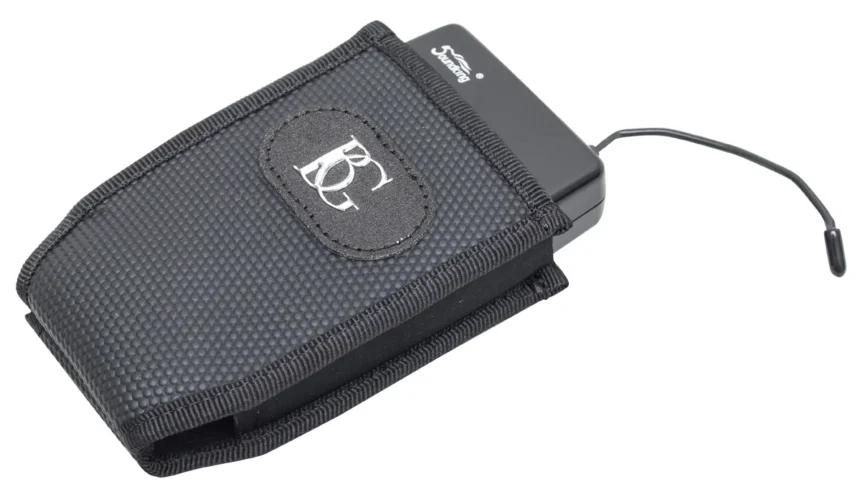When it comes to using elastic bands to hold wireless transmitter on saxophone, finding the right solution can make all the difference. These bands can help keep your wireless transmitter secure, so it doesn’t interfere with your music. Whether you’re a beginner or a pro, using elastic bands the right way will keep your setup neat and stable.
In this blog, we’ll explore how elastic bands to hold wireless transmitter on saxophone can solve common issues. From choosing the best types of bands to tips on how to attach them, you’ll learn everything you need to make your saxophone performance smoother and more enjoyable.
What Are Elastic Bands to Hold Wireless Transmitter on Saxophone?
Elastic bands to hold wireless transmitter on saxophone are simple but essential tools for keeping your transmitter in place. These bands wrap around the saxophone and hold the transmitter securely, so it doesn’t move while you play. They help avoid interruptions in your performance and ensure your music sounds great Elastic Bands to Hold Wireless Transmitter on Saxophone.
These bands are flexible and easy to use, making them a popular Elastic Bands to Hold Wireless Transmitter on Saxophone choice among musicians. They come in different sizes and strengths to fit various saxophone models and transmitter sizes. Using the right band can make a big difference in how well your transmitter stays in place during a performance.
You might be surprised at how effective these bands can be. They provide a simple solution to a common problem, keeping your gear secure without needing complex setups. For many saxophonists, they are an easy and affordable way to ensure their wireless equipment stays put Elastic Bands to Hold Wireless Transmitter on Saxophone.
Why Use Elastic Bands to Hold Wireless Transmitter on Saxophone?
Using elastic bands to hold wireless transmitter on saxophone offers several benefits. First, they provide a secure fit, which prevents the transmitter from slipping or moving during your performance. This is crucial for maintaining a steady connection and avoiding any interruptions in your soundElastic Bands to Hold Wireless Transmitter on Saxophone.
Elastic Bands to Hold Wireless Transmitter on Saxophone Another advantage is their flexibility. These bands can be adjusted to fit different transmitter sizes and saxophone models. This means you can use them with various setups, making them a versatile choice for many musicians.
Additionally, elastic bands are easy to attach and remove. This makes setting up and packing down your saxophone quick and simple. They are also affordable, making them a practical option for musicians on a budget.
Top Features to Look for in Elastic Bands for Your Saxophone
Elastic Bands to Hold Wireless Transmitter on Saxophone When choosing elastic bands to hold your wireless transmitter on saxophone, it’s important to consider several key features. First, look for bands that offer good stretch and flexibility. This ensures that they can accommodate different transmitter sizes and stay securely in place.
Another important feature is durability. The bands should be strong enough to hold the transmitter firmly without snapping or wearing out quickly. Elastic Bands to Hold Wireless Transmitter on Saxophone Quality materials, like high-grade rubber or silicone, often provide better longevity and performance.
Comfort is also a factor to consider. Elastic Bands to Hold Wireless Transmitter on Saxophone The bands should not interfere with your playing or make the saxophone uncomfortable. Opt for bands that offer a snug fit without being too tight or causing any discomfort.
How to Choose the Best Elastic Bands to Hold Wireless Transmitter on Saxophone

Elastic Bands to Hold Wireless Transmitter on Saxophone Choosing the best elastic bands to hold wireless transmitter on saxophone involves evaluating a few key factors. Start by considering the size of your transmitter. Different bands work better for different sizes, so make sure you choose one that fits your equipment.
Next, think about the material. Bands made from durable materials like silicone or high-quality rubber tend to last longer and offer better grip Elastic Bands to Hold Wireless Transmitter on Saxophone. Check reviews or ask other musicians for recommendations on reliable brands and materials.
You should also consider the ease of use. Look for bands that are simple to attach and adjust. This will make your setup process quicker and more efficient, Elastic Bands to Hold Wireless Transmitter on Saxophone allowing you to focus more on your performance.
Easy Steps to Attach Elastic Bands to Your Saxophone Transmitter
Attaching elastic bands to your saxophone transmitter is a straightforward process. Start by wrapping the band around the transmitter and saxophone. Make sure the band is snug but not too tight, as this could affect your playing comfort.
Next, adjust the band to ensure the transmitter is securely held in place. It should not move or shift during your performance. You may need to experiment with the placement to find the best position that keeps the transmitter stable.
Finally, test the setup before you start playing. Move around and play a few notes to ensure the transmitter stays securely attached. Elastic Bands to Hold Wireless Transmitter on Saxophone Making sure everything is in place before your performance can help avoid any issues during your gig.
Common Problems with Elastic Bands on Saxophones and How to Fix Them
Using elastic bands on saxophones can sometimes lead to a few common problems. One issue is that the bands might slip or move during use Elastic Bands to Hold Wireless Transmitter on Saxophone. To fix this, make sure the bands are the right size and fit snugly. You can also try using bands with better grip or texture.
Another problem is wear and tear. Elastic Bands to Hold Wireless Transmitter on Saxophone Over time, bands can stretch out or become damaged. Regularly check your bands for any signs of wear and replace them as needed to keep your setup secure.
Finally, sometimes the bands might interfere with your playing. If this happens, adjust the placement of the band or try a different type that offers better comfort. Elastic Bands to Hold Wireless Transmitter on Saxophone Ensuring that the bands do not disrupt your playing is key to a successful performance.
DIY Tips for Making Your Own Elastic Band Setup
Creating your own elastic band setup for your saxophone can be a fun and practical DIY project. Start by selecting high-quality elastic bands that are strong and durable. Measure the bands to ensure they fit your transmitter and saxophone properly Elastic Bands to Hold Wireless Transmitter on Saxophone.
You can also customize the bands by adding padding or adjusting their size. This can help make the setup more comfortable and secure. Elastic Bands to Hold Wireless Transmitter on Saxophone Use fabric or other materials to create a more personalized fit.
Finally, test your DIY setup thoroughly before using it in a performance. Ensure that the transmitter stays in place and that the bands do not interfere Elastic Bands to Hold Wireless Transmitter on Saxophone with your playing. Making adjustments as needed will help you create a reliable and effective setup.
The Best Elastic Bands to Hold Wireless Transmitter on Saxophone: A Buying Guide
When shopping for the best elastic bands to hold wireless transmitter on saxophone, look for a few key qualities. First, check the material. Bands made from high-quality rubber or silicone offer better durability and grip.
Also, consider the size and stretch of the bands. They should be able to fit your transmitter securely without being too tight. Adjustable bands are a good option as they can be customized to fit different setups.
Lastly, read reviews and seek recommendations from other musicians. This can help you find reliable brands and avoid common issues. Investing in good-quality bands will enhance your performance and keep your transmitter securely in place.
How to Adjust Elastic Bands for Different Saxophone Models
Elastic Bands to Hold Wireless Transmitter on Saxophone saxophone models involves a few simple steps. Start by measuring the bands to ensure they fit your saxophone and transmitter. Different models may require different sizes or types of bands.
Next, adjust the tightness of the bands. Some saxophones may need a looser or tighter fit depending on their shape and size. Experiment with different adjustments to find the best fit for your specific saxophone model.
Finally, test the setup to ensure the transmitter stays securely in place. Make any necessary adjustments to improve the fit and stability. Proper adjustment will help ensure that your transmitter remains secure during your performance.
How to Maintain and Care for Your Elastic Bands and Transmitter Setup
Maintaining and caring for your elastic bands and transmitter setup is essential for long-term performance. Regularly inspect the bands for any signs of wear or damage. Replace any bands that are stretched out or damaged to ensure a secure fit.
Keep the bands clean by wiping them with a damp cloth. Avoid using harsh chemicals that could damage the material. Proper cleaning helps extend the life of the bands and keeps your setup in good condition.
Store your saxophone and transmitter setup in a cool, dry place. Avoid exposing the bands to excessive heat or moisture, as this can weaken them over time. Proper care and storage will help keep your setup reliable and in good shape.
Elastic Bands vs. Other Transmitter Mounting Solutions: Which is Better?
Elastic bands and other transmitter mounting solutions each have their pros and cons. Elastic bands are flexible, easy to use, and affordable. They can be adjusted to fit different sizes and are a popular choice among many musicians.
Other mounting solutions, such as specialized clips or holders, offer different benefits. They may provide a more secure fit or be designed specifically for certain transmitter models. However, they can also be more expensive and less flexible than elastic bands.
Choosing the best option depends on your specific needs and preferences. Consider factors like ease of use, cost, and compatibility when making your decision. Both elastic bands and other solutions can work well, depending on what you’re looking for.
How to Avoid Slippage with Elastic Bands on Your Saxophone
To avoid slippage with elastic bands on your saxophone, start by choosing bands with good grip. Bands made from high-quality rubber or silicone often provide better traction and prevent slipping.
Ensure the bands are the right size and fit snugly around your transmitter and saxophone. Bands that are too loose or too tight can lead to movement or discomfort. Adjust the bands as needed to achieve a secure fit.
Regularly check the bands for any signs of wear or stretching. Replace them if they become worn out to maintain a secure setup. Proper maintenance and adjustment will help prevent slippage and keep your transmitter in place.
The Benefits of Using High-Quality Elastic Bands for Your Saxophone
Using high-quality elastic bands for your saxophone offers several benefits. These bands provide better durability, meaning they last longer and withstand regular use. They also offer a more secure fit, helping to keep your transmitter in place during performances.
High-quality bands often have better grip and flexibility. This makes them more effective at holding your transmitter securely without slipping or moving. They are also generally more comfortable to use, ensuring that your setup does not interfere with your playing.
Investing in good-quality bands can improve your overall performance experience. They help avoid interruptions and ensure that your equipment stays securely attached, allowing you to focus on playing your best.
Reviews: Top Elastic Bands to Hold Wireless Transmitter on Saxophone
Reading reviews can help you find the best elastic bands to hold wireless transmitter on saxophone. Look for bands with positive feedback on their durability, fit, and ease of use. Reviews from other musicians can provide valuable insights into which bands work well.
Check for specific comments about how well the bands hold up during performances and if they offer good grip. Some bands may have additional features, like adjustable sizes or better materials, which can enhance their performance.
Compare different brands and types based on user reviews to find the most reliable option. Choosing bands with high ratings and positive experiences can help ensure that you get a product that meets your needs.
Expert Advice on Using Elastic Bands for Saxophone Transmitters
Expert advice on using elastic bands for saxophone transmitters can help you get the best performance from your setup. Professionals often recommend choosing bands that are both durable and flexible to ensure a secure fit.
It’s also important to properly adjust the bands for your specific saxophone and transmitter. Experts suggest testing different placements and tightness to find what works best for your setup.
Regular maintenance is another key tip. Keep the bands clean and replace them if they show signs of wear. Following expert advice can help you achieve a reliable and effective setup for your saxophone.
Budget-Friendly Elastic Bands for Wireless Transmitters: What to Consider
Finding budget-friendly elastic bands for wireless transmitters doesn’t mean you have to sacrifice quality. Look for bands made from durable materials that offer good value for money. Affordable options can still be effective if they meet your needs.
Check for bulk or multi-pack deals, which can provide cost savings. This allows you to have extra bands on hand for replacements or different setups. Also, consider reading reviews to ensure that budget-friendly bands still perform well.
Keep in mind that while cost is important, the quality and fit of the bands should not be overlooked. Balancing affordability with performance will help you get the best value for your money.
How Elastic Bands Help Secure Wireless Transmitters on Your Saxophone

Elastic bands are incredibly useful for securing wireless transmitters on your saxophone. They provide a flexible and adjustable solution to keep your equipment in place. When you use these bands, you ensure that your transmitter remains stable, which is crucial for a clear and uninterrupted sound.
Elastic bands work by wrapping around your saxophone and transmitter, holding them together without damaging your instrument. The stretchy nature of the bands allows them to accommodate different sizes and shapes, making them versatile for various setups. This flexibility helps you find the perfect fit for your specific needs.
The bands are also designed to grip tightly without slipping. This means your transmitter won’t move around or get knocked loose during energetic performances. By keeping your transmitter securely attached, you prevent any potential issues with signal loss or disconnection, which can be a real problem during live shows.
using elastic bands is an affordable solution. They are less expensive than many specialized mounting systems but still offer reliable performance. This cost-effectiveness makes them a popular choice among both amateur and professional saxophonists. Overall, elastic bands are a practical and efficient way to ensure your wireless transmitter stays securely attached to your saxophone.
How to Install Elastic Bands for Optimal Performance
Installing elastic bands on your saxophone for optimal performance is a simple process that can greatly enhance your setup. Start by choosing the right size and type of band. You want a band that is strong enough to hold the transmitter securely but flexible enough to fit comfortably around your saxophone.
Begin by wrapping the band around the transmitter and the saxophone. Position the band so that it holds the transmitter snugly but does not interfere with your playing. The goal is to keep the transmitter stable without adding any extra bulk or discomfort. Adjust the band as needed to ensure a secure fit.
After wrapping the band, check to make sure the transmitter does not shift or move. It should remain in place even when you are playing vigorously. If you find that the band is too loose or too tight, adjust it accordingly. Proper adjustment is key to preventing any slippage or discomfort.
Once the band is installed and adjusted, test the setup by playing your saxophone. Move around and play a few notes to ensure that the transmitter stays secure and does not affect your performance. This final check helps ensure that everything is set up correctly and that your transmitter remains reliably attached throughout your performance.
Conclusion
In conclusion, using elastic bands to hold a wireless transmitter on your saxophone is a smart and simple solution. They are easy to use, affordable, and versatile, making them a great choice for both beginners and experienced players. Just make sure to choose the right size and keep the bands in good condition to ensure they work well.
If you follow the tips and tricks mentioned in this blog, you’ll find that elastic bands can help keep your transmitter secure and your performance smooth. Don’t be afraid to experiment with different bands and setups until you find what works best for you. Happy playing, and may your wireless setup always stay in place!







